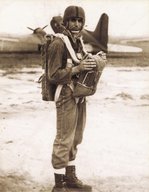
|

|
|
|
|
He was born at the corner of Texas Avenue and Gary Street in Shreveport where his father, Salvatore Santoro, a native of Sicily, ran a grocery store. Salvatore had come to America in 1903 at age 20. His mother, Catherine Schumacher, arrived here when she was four. She came from the same town in Sicily, settling with her family in Alamance, Texas. Anthony, or Tony, was one of five brothers and three sisters. He does not have a birth certificate and is not certain whether he was born in 1922 or 1923. As a boy Tony was soon helping out out in the store. At night, the family simply climbed the stairs to their rooms in a building heated with wood. All the boys and sisters did not play. "No games," Tony recalls. "We worked in the garden and from the grocery story to the farm." The 40- to 50-acre garden, on land the elder Santoro leased from T&P Railroad, was located on Austin Hill, bisected now by Common Street. Tony worked at other enterprises to supplement the family income. He sold produce on the street, helped transport bales of cotton to the gin on Commerce Street, and delivered telegrams for Western Union, ultimately making 25 cents an hour. He fished and dug mushrooms on the bayou to supplement the fare on the family table. His father's last store, The Blue Goose on Snow and Pickett Streets, closed when he couldn't pay the rent, so he moved to the farm. "He built a shack and that's what we lived in on the farm," he says. "Times were hard," he continues. "We used to go along the railroad tracks picking berries to have something to eat. That's why I joined the army," he states, concerning the poor economic conditions for the family. At Fort Benning near Columbus, Georgia, Tony was first placed in the drum and bugle corps of 8th Infantry. When the paratroopers were formed, he joined 1st Battalion, earning fifty dollars in jump pay, in addition to twenty-one dollars a month as a regular soldier. After jump training he underwent jungle training in Panama. Tony was placed in the 501st Parachute Battalion. He was at the movies in Panama City, Panama when he heard the announcement about the bombing of Pearl Harbor. It took several hours for him to return to the barracks, only to find "the lights were out and ammunition was thrown all over the floor. "We dug foxholes with our hands in the sand on the beach," he recalls. He got jungle rot and says "I still itch from it to this day." Sent to the Pacific theater, Tony jumped with the battalion into Lae, New Guinea in September of 1943. Landing on his back he was knocked unconscious. He awoke lying in kunai grass "about six or seven feet tall". The battalion captured the Japanese airstrip in the operation. Tony's time in combat was cut short when he was stricken with appendicitis. From Port Moresby he returned to America and to the VA Hospital in Shreveport. On July 11, 1944 he married Lois Corena Wilkes, who worked at Barksdale Field. (They would have two children.) He joined the cadre at Fort Benning to become a training captain, making his last jump on his birthday, March 14, 1945, in spite of his back problem. "I went back to the hospital and that's when they said I was no longer fit for the service. I said I'd go ahead and get out," he recalls. Tony worked for Southwestern Electric Power Company for nearly 35 years, retiring in 1980. 2 |


